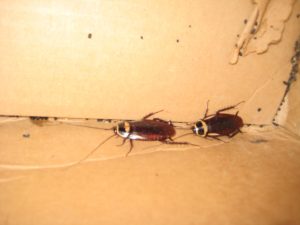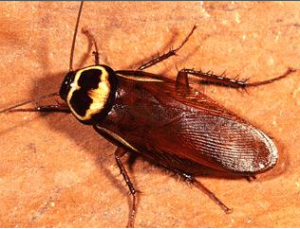 The Australian roach is a relative of the American cockroach, with whom it shares a very close resemblance and is often confused one for another. Just like its cousin, the Australian cockroach prefers to live outside rather than indoors. They are very fond of warm temperatures, but in colder seasons they will look for shelter and warmer temperatures.
The Australian roach is a relative of the American cockroach, with whom it shares a very close resemblance and is often confused one for another. Just like its cousin, the Australian cockroach prefers to live outside rather than indoors. They are very fond of warm temperatures, but in colder seasons they will look for shelter and warmer temperatures.
The Australian cockroach also shares the same running speed that the American cockroach does and is capable of flight. Although named Australian it is believed to be from Asia. This roach seems to prefer plant and vegetation materials for food but can eat much the same as the American roach. (decaying organic matter). This roach can be found in drier locations as long as water is present near by.
They are prolific breeders and complete their life cycle in about one year. Oothecas (egg capsules) hold up to 30 eggs of which only about 1/2 hatch. Eggs take about 40 days to hatch and nymphs reach maturity in about a year.
How They Travel
Speed on the ground helps this roach escape sprays and stomps from homeowners feet. Also able to fly this roach can migrate to newer locations in search of food or water. Being able to tolerate drier conditions this roach can survive hiding away in boxes or cargo and is quite often shipped to new locations. It is believed that the Australian roach was introduced not only to Australia, but North America as well via ships.
How Best To Identify Australian Roaches
A typical American roach adult can grow up to more than 1 1/2 inch, but the Australian roach can only grow up to about 1 1/4 inch. Reddish brown in color they have very long antenna and the same ‘eye’ pattern on their thorax. (just behind the head) The Australian roach is best identified however by yellow stripes on the sides of their thorax. American roaches do not have this marking.
inch. Reddish brown in color they have very long antenna and the same ‘eye’ pattern on their thorax. (just behind the head) The Australian roach is best identified however by yellow stripes on the sides of their thorax. American roaches do not have this marking.
Treatment And Elimination
Since this pest often enters wall voids through pipe lines, wood rotted siding or soffits, crawl spaces or other openings, dusting the voids is very beneficial. Delta, Drione, DE (diamataceous earth) and Boric acid are all very good choices with Delta being top of the list due to its resistance to moisture. Inside voids in basements, under sinks, where utility pipes enter, drop ceilings, in garages under shelves and behind storage and other voids will provide long lasting barriers. Exterior entry points such as cracks in foundation, base of siding, around doors and windows, voids around light fixtures and areas of wood decay or other gaps should be dusted thoroughly to stop this roach from entering. Note; Ready made store bought ‘bottle’ dusters are not as versatile as bulb, puff or bellow dusters and you should consider the purchase of a proper application tool.
Liquid sprays do a nice job for Australian roach control in cracks and crevices or as spot treatments where dusts are not desirable. (areas that are not a void or generally inaccessible) Demand CS, Suspend SC and Tempo work very well as residual barriers. Inside places to spray might include in dark areas where this roach may hide such as under refrigerators, under sinks or cabinets, baseboard cracks or gaps, doorway areas, behind furniture, exposed ceilings along walls in basements or near areas of moisture such as around but not in sump pumps. Outside areas may be around doors and windows, eaves and gutters, base of home and gaps, cracks or other entry points this roach may use.
Baits such as Niban are an excellent choice for control and can be used both inside and out. Attics, wall voids, garages, around sump pumps, under refrigerators or basement stairs or furnishings and in utility rooms to name a few are great places to bait. Outside baiting is best in mulched and landscaped areas, in, under and around sheds, under planters, splash blocks, wood piles, grills, idle cars or boats, railroad tie walls or other landscaped features.
Granule barriers work as well but are not as effective in heavy mulch but can be applied OUTDOORS in the same general areas as baits. Talstar PL granule or a generic brands are very effective for this application and pest. Label instructions need to be scrutinized carefully to see restrictions and safety precautions.




